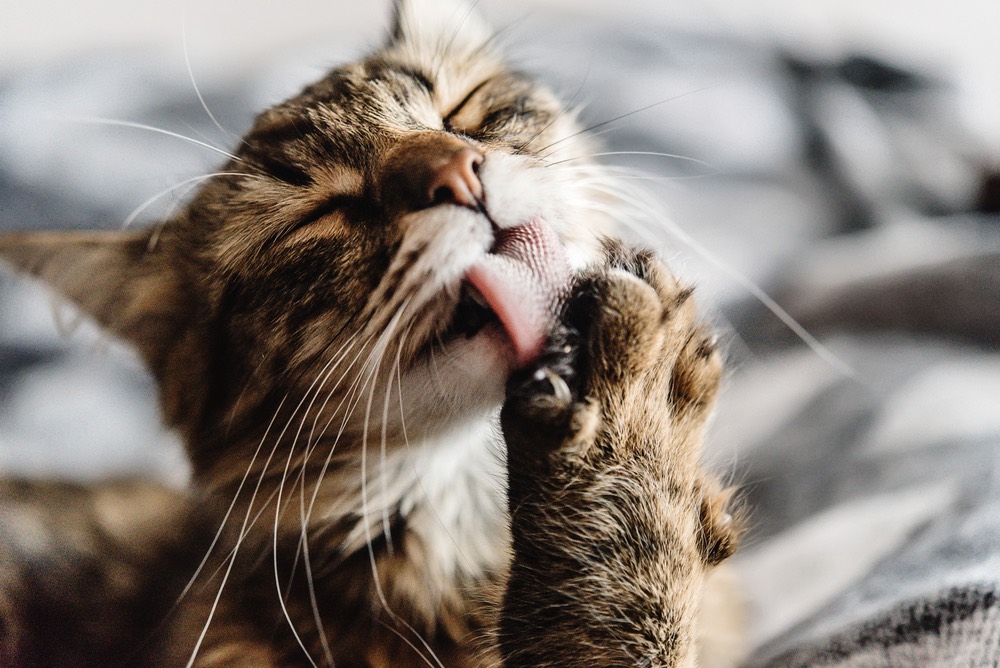Hair Ball! How Cats' Tongues Get Them So Clean

Cats are famous for their fastidious self-grooming, but the way their tongues are able to get them so clean has remained somewhat of a mystery. Scientists knew that feline tongues were covered in spines, and now a group of engineers has found that the teensy structures are shaped like claws and work like Velcro to clean cats' coats.
The findings could help engineers design robots that can grip surfaces, and even lead to more efficient hairbrushes and better ways to clean wounds, the researchers said. [20 Weird Dog and Cat Behaviors Explained by Science]
Cat licks
Alexis Noel, a mechanical engineer at the Georgia Institute of Technology in Atlanta, began investigating the spines on cat tongues after she watched a cat lick a thick blanket and it immediately got its tongue stuck.
"I was home for the holidays and watching TV with the family cats," Noel said. "Murphy, a 3-year-old male cat — short-haired breed, with tan stripes — decided that the couch blanket smelled tasty, and decided to give it a good lick.
"When I was done laughing at this curious cat, the scientist in me began to question how a soft, wet tissue could stick to something so easily," Noel told Live Science. "After a few seconds of struggle, he figured out that he could detach his tongue by simply pushing his tongue into the blanket rather than pulling, de-hooking the blanket loops."
Using high-speed video cameras, Noel and her colleagues recorded a cat removing cat food deeply wedged into a 3D-printed fur mat. They also 3D-printed a model of a cat tongue four times bigger than normal and experimented with it.
"We are the first to 3D-print a cat tongue mimic," Noel said.
Sign up for the Live Science daily newsletter now
Get the world’s most fascinating discoveries delivered straight to your inbox.
The scientists noted that cats' tongue spines are curved and sharp. "In terms of shape and sharpness, it reminds me of cat claws," Noel said in a statement. The spines' hook-like nature essentially helps them behave like Velcro: As cat tongues glide over fur, their spines catch on tangles of hair, she said.
Moreover, "when the cat's tongue hits a snag, it pulls on the hooks, which rotate to penetrate the snag even further," Noel said in the statement. "Like a heat-seeking missile for snags, the hook's mobility allows the cat to better tease tangles apart." The rotating behavior of these hooks also helps wedge particles between them, helping them catch food, the researchers added.
Noel's future research will explore how the spacing of cat tongue spines influences how well they groom, and how the lubricating layer of saliva on the cat tongue helps or hinders grooming.
"While saliva is known to break up dirt and oil, reducing fur matting, prior research has shown that wetting actually increases friction between hairs, which would make the brush more likely to yank hair out of the skin — painful!" Noel said.
In addition, they "are also looking to acquire tongues from tigers, lions and other large cats to understand how the tongue spines scale across the cat family," Noel said. "However, this may prove difficult to study, since exotic animal tongues are difficult to locate and acquire," she added.
Cat-tongue tech
This research could help scientists design soft robots capable of gripping items, Noel said. Whereas conventional robots are rigid — which makes them vulnerable to harm from bumps, scrapes, twists and falls — soft robots made from elastic plastic and rubber are resistant to many kinds of damage, and can wriggle past obstacles that can impede hard robots. [7 Cool Animal-Inspired Technologies]
"In the world of soft robotics, researchers are still struggling on ways for soft materials to grip surfaces," Noel said. Research on cat tongues might help overcome this challenge — they are flexible just like floppy soft-robot limbs "and yet can pull apart tangles in fur," she added.
These findings also could lead to better hairbrushes, Noel said.
"The first-known hairbrush is dated back to 8000 B.C.," Noel said. "Since then, the hairbrush design really has not changed. We look to understand what makes hair detangling less painful, and how the cat tongue can be scaled to suit human hair, providing a novel design to the traditional hairbrush."
The finding could lead to easier-to-clean hairbrushes. "A typical hairbrush has spines that stick straight out. When hair collects on the brush, it forms a thick mat that must be removed by hand," Noel said in the statement. In contrast, when not in use, the spines on a cat tongue lie nearly flat against its surface, like overlapping shingles. This allows "the mat of hair around the bristles to be removed with a single finger swipe. These openings face the cat's throat and are also why cats swallow their hair and end up with hair balls."
The researchers "will be developing the cat tongue mimic technology through the Innovation Corps at Georgia Tech," where they "plan to talk to consumers, beauty specialists and medical device specialists around the U.S. for application opportunities," Noel said. "We have submitted a provisional patent for this technology and plan to develop an application within the next year."
Noel said there were questions from other scientists as to how they plan to compare the cleaning efficiencies of cat tongue mimics to those of regular hairbrushes. "I recently developed a grooming machine which drags brushes through fur and measures the resistive forces," Noel said. "With this grooming machine, we can compare the friction forces associated with brushing to material properties of both the hair and brush."
The scientists detailed their findings Nov. 21 at the annual meeting of the American Physical Society's Division of Fluid Dynamics in Portland, Oregon.
Original article on Live Science.










